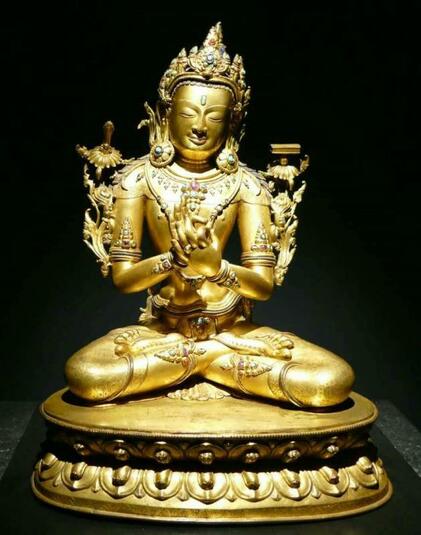
Item: Manjushri (Bodhisattva & Buddhist Deity)
| Origin Location | Tibet |
|---|---|
| Date Range | 1400 - 1499 |
| Lineages | Sakya and Buddhist |
| Material | Metal, Mercuric Gild |
| Collection | Private |
Classification: Deity
Arya Manjushri, the Gentle Voiced Noble One, from the tradition of the Siddhaikavira and the Manjushri Mulakalpa Tantras. Based on an inscription from another sculpture, in the same style, the artist was Sonam Gyaltsen or an artist of the atelier (circa 1430).
There are many traditions for depicting the iconography of Manjushri and there are two main distinct iconographic styles for depicting the bodhisattva figures. The first is dynamic depiction where the artist has a tremendous amount of freedom in body movement and expression. This type of appearance is based on the descriptions and narratives of the Mahayana Sutras. The second type of appearance is based on the Tantra literature of Vajrayana Buddhism. The artist is very much restricted to portraying the figures in very static postures and expression as dictated by the very technical source literature. The earliest and most common descriptions of the forms of Manjushri are found in the literature of the Siddhaikavira and Manjushri Mulakalpa Tantras.
This figure of Manjushri has one face and two arms. The hands are crossed at the heart in a teaching gesture while holding the stems of two utpala flowers blossoming on the right and left sides. The pair of flowers support an upright sword of wisdom on the proper right side and a text of the Prajnaparamita sutra on the left side. Seated upright he has the two legs crossed one over the other in vajra posture atop a double lotus seat. The surface of the sculpture is adorned with mercuric gild and decorated with small stones such as turquoise.
There are no inscriptions of any kind to be found on the work. The identification of the date and possible identification of the artist are entirely based on comparison with other similar sculpture, and one in particular, an Eleven Faced Avalokiteshvara, which has a lengthy inscription. Based on the two sculptures being of the same style and comparable quality the date can be tentatively given as roughly the same as the inscribed Lokeshvara.
For the Lokeshvara the inscription is written in Tibetan U-chen script located on the lotus base which is somewhat unusual. It names a famous Sakya teacher, Zhonnu Gyalchog, two brothers, Norbu Zangpo and Palzang, one more famous than the other, and the artist, Sonam Gyaltshen, that created the sculpture.
Norbu Zangpo (1403-1466), also known as Rinpungpa, was the third and most powerful ruler of the Rinpung dynasty of Tibet from 1435 until 1466. The dynasty lasted until 1565. Rinpungpa had a brother named Palzang and both were students of the famous Sakya teacher Zhonnu Gyalchog (birth 14th century [P1943]). This teacher was also known to be a direct student of Je Tsongkapa Lobzang Dragpa (1357-1419).
Rinpungpa and Zhonnu Gyalchog founded a monastery called Jamchen Chode in Tsang Province (approximately 1430). The monastery was consecrated by Lotsawa Nag Rinchen. The monastery, Sakya by tradition, later fell into disrepair and was renovated and restored by the 5th Dalai Lama, Lobzang Gyatso (1617-1682) and renamed Jampa Ling. According to some sources the monastery was originally a small hermitage founded in 1367 and later converted to the Gelug tradition in 1650. If this information is accurate then it is possible that the monastery, previously built, was restored or enlarged upon by Rinpungpa and his teacher Zhonnu Gyalchog. The exact history is difficult to untangle as there are several different textual sources with varying dates and information.
Rinpung Rulers: - Namkha Gyaltsen (dates?) - Namkha Gyalpo (dates?) - Norbu Zangpo (ruled from 1435-1466) - Donyo Dorje (ruled from 1479-1512) - Ngagwang Jigme Dragpa (ruled from date? - 1565/1595)
English Text: "This source of the attainments of Lord Avalokiteshvara, requested by the bodhisattva Zhonnu Gyalchog, [fulfilled] by the ruling brothers Norzang and Palzang, with pure motivation to build a place of worship for noble beings, [then, this sculpture was made] by the hands of Sonam Gyaltsen: May the accumulation of merit lead all beings to quickly attain the omniscient stage."
Tibetan Text: ༄༄།སྭསྟི། སྤྱན་རས་གཟིགས་དབང་དངོས་གྲུབ་འབྱུང་གནས་འདི། རྒྱལ་སྲས་གཞོན་ནུ་རྒྱལ་མཆོག་བཀས་བསྐུལ་ནས། མི་དབང་ནོར་བཟང་དཔལ་བཟང་སྐུ་མཆེད་ཀྱིས། ལྷག་བསམ་དག་པས་འཕགས་སྡེའི་མཆོད་གནས་བཞེངས། བསོད་ནམས་རྒྱལ་མཚན་ལག་པས་རྩེ་ལས་འཁྲུངས། དགེ་བས་འགྲོ་ཀུན་ཀུན་མཁྱེན་མྱུར་ཐོབ་ཤོག།
At least twenty-five sculpture in the same or similar style are known to exist in museum and private collections around the world likely created by the same artist, Sonam Gyaltsen, or by his associated atelier and immediate descendants
Jeff Watt 6-2018
Bibliography: The Jamchen Avalokiteshvara by Sonam. Written in collaboration with Jeff Watt, February 2018 (Bonhams March Catalogue, New York).
Artist: Sonam Gyaltsen & Atelier (Peaceful Figures)
Collection of Zhiguan (Sculpture)
Buddhist Deity: Manjushri, Arapachana (Various Forms)
Buddhist Deity: Manjushri Number Sets
Buddhist Deity: Manjushri Sculpture Page
Buddhist Deity: Manjushri (Sculpture Masterworks)
Artist: Sonam Gyaltsen & Atelier (Sculpture)
Collection of Zhiguan Museum of Fine Art
Sculpture: Sonam Gyaltsen & Atelier (Gilded Masterworks)
Buddhist Deity: Manjushri (Teaching Gesture, Sculpture)
Buddhist Deity: Manjushri, 3 Iconographic Topics (Arapachana)
